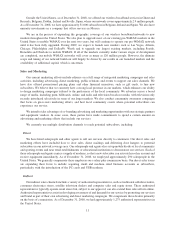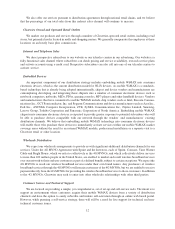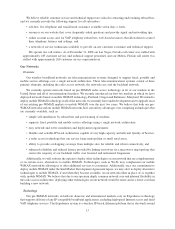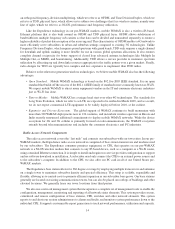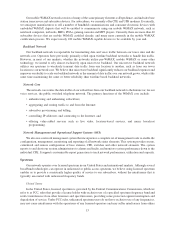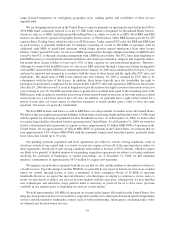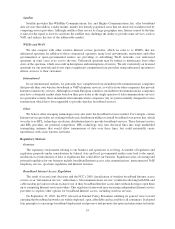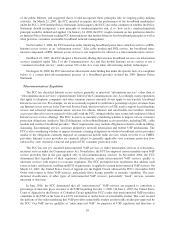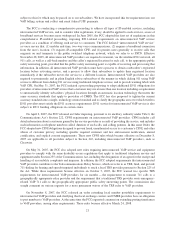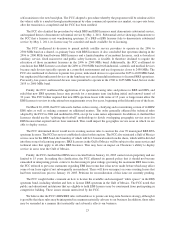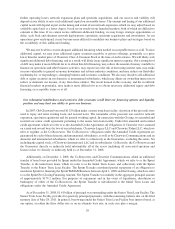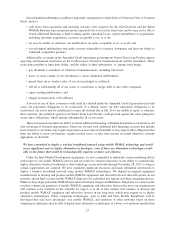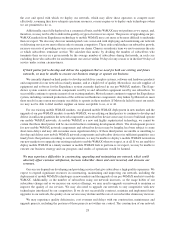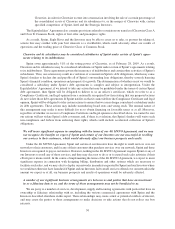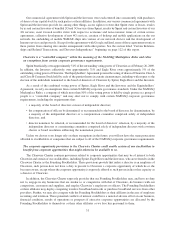Clearwire 2008 Annual Report Download - page 33
Download and view the complete annual report
Please find page 33 of the 2008 Clearwire annual report below. You can navigate through the pages in the report by either clicking on the pages listed below, or by using the keyword search tool below to find specific information within the annual report.s
u
bj
ect to t
hi
s
f
ee w
hi
c
h
may
b
e passe
d
on to our su
b
scr
ib
ers. We
h
ave
i
ncorporate
d
t
hi
s
f
ee requ
i
rement
i
nto ou
r
V
oIP
billi
ng system an
d
co
ll
ect an
d
rem
i
t
f
e
d
era
l
USF payments
.
T
he FCC is conductin
g
a comprehensive proceedin
g
to address all t
y
pes of IP-enabled services, includin
g
i
nterconnected VoIP service, and to consider what re
g
ulations, if an
y
, should be applied to such services, as use of
broadband services becomes more widespread. In June 200
5
, the FCC adopted the first set of re
g
ulations in this
c
omprehensive IP-enabled proceedin
g
, imposin
g
E911-related requirements on interconnected VoIP servic
e
p
roviders as a condition of offerin
g
such service to consumers. The FCC defined “interconnected VoIP service”
as voice service that: (1) enables real-time, two-wa
y
voice communications; (2) requires a broadband connection
f
rom t
h
e user’s
l
ocat
i
on; (3) requ
i
res IP-compat
ibl
e CPE; an
d
(4) perm
i
ts users
g
enera
lly
to rece
i
ve ca
ll
st
h
at
ori
g
inate on and terminate to the public switched telephone network, which we refer to as PSTN. Effectiv
e
November 28, 200
5
, all interconnected VoIP
p
roviders are re
q
uired to transmit, via the wireline E911 network, al
l
911 calls, as well as a call-back number and the caller’s re
g
istered location for each call, to the appropriate publi
c
s
afet
y
answerin
g
point, provided that the public safet
y
answerin
g
point is capable of receivin
g
and processin
g
tha
t
i
nformation. In addition, all interconnected VoIP providers must have a process to obtain a subscriber’s registere
d
location before activatin
g
service, and a process to allow their subscribers to update their re
g
istered locatio
n
i
mmediatel
y
if the subscriber moves the service to a different location. Interconnected VoIP providers are also
r
equired to prominentl
y
and in plain En
g
lish advise subscribers of the manner in which dialin
g
911 usin
g
Vo I
P
s
ervice is different from dialin
g
911 service usin
g
traditional telephone service, and to provide warnin
g
labels with
V
oIP CPE. On May 31, 2007, the FCC initiated a proceeding proposing to adopt additional E911 obligations for
p
rov
id
ers o
fi
nterconnecte
d
VoIP serv
i
ce t
h
at a customer may use at more t
h
an one
l
ocat
i
on
i
nc
l
u
di
ng a requ
i
rement
t
o automaticall
y
identif
y
subscribers’ ph
y
sical locations throu
g
h an automatic location technolo
gy
that meets th
e
s
ame accurac
y
standards that appl
y
to providers of CMRS. The FCC has also proposed to ti
g
hten the curren
t
accuracy standards into a single, technology neutral standard and to clarify the geographic area over which wireless
E911 providers must satisfy the E911 accuracy requirements. E911 service for interconnected VoIP service is also
s
u
bj
ect to E911
f
un
di
ng o
bli
gat
i
ons
i
n certa
i
n states
.
On April 2, 2007, the FCC released an Order imposin
g
, pursuant to its ancillar
y
authorit
y
under Title I, th
e
Communications Act’s Section 222, CPNI re
q
uirements on interconnected VoIP
p
roviders. CPNI includes cal
l
detail information about a customer
g
ained b
y
the service provider as a result of providin
g
the service, and includes
s
uch information as telephone numbers called, duration of such calls, and callin
g
patterns. In this same Order, th
e
FCC adopted new CPNI obli
g
ations desi
g
ned to prevent fraud, unauthorized access to a customer’s CPNI, and othe
r
abuses of customer privac
y
, includin
g
specific required customer and law enforcement notification, annual
c
ertification, and ex
p
licit consent re
q
uirements. These new CPNI rules which became effective on December 8,
2007 are applicable to all providers subject to Section 222, including interconnected VoIP providers, such a
s
Clearwire.
On Ma
y
31, 2007, the FCC also adopted new rules requirin
g
interconnected VoIP service and equipmen
t
p
roviders to compl
y
with the same disabilit
y
-access re
g
ulations that appl
y
to traditional telephon
y
service an
d
e
quipment under Section 255 of the Communications Act, includin
g
the desi
g
nation of an a
g
ent for the receipt an
d
h
an
dli
ng o
f
access
ibili
ty comp
l
a
i
nts an
di
nqu
i
r
i
es. In a
ddi
t
i
on, t
h
e FCC a
d
opte
d
requ
i
rements t
h
at
i
nterconnecte
d
V
oIP prov
id
ers contr
ib
ute to t
h
eTe
l
ecommun
i
cat
i
ons Re
l
ay Serv
i
ce, w
hi
c
h
we re
f
er to as TRS,
f
un
d
,an
d
prov
ide
711-dialing for hearing and speech-impaired individuals to reach a local TRS provider pursuant to Section 225 o
f
t
he Act. While these requirements became effective on October 5, 2007, the FCC waived two specific TRS
r
equ
i
rements
f
or
i
nterconnecte
d
VoIP prov
id
ers
f
or s
i
x mont
h
s—t
h
e requ
i
rement to transm
i
t 711 ca
ll
stoa
geograp
hi
ca
ll
y appropr
i
ate re
l
ay prov
id
er an
d
t
h
e requ
i
rement t
h
at a tra
di
t
i
ona
l
TRS prov
id
er route emergency
-
r
elated VoIP 711 calls to the geographically appropriate public safety answering points. The commission also
s
ou
g
ht comment on various requests for a more permanent waiver of the TRS rules to VoIP providers
.
On November 8, 2007, the FCC released an order extendin
g
local number portabilit
y
requirements t
o
i
nterconnecte
d
VoIP prov
id
ers an
d
c
l
ar
ifyi
n
g
t
h
at
l
oca
l
exc
h
an
g
e carr
i
ers an
d
CMRS prov
id
ers
h
ave an o
blig
at
i
on
t
o port num
b
ers to VoIP prov
id
ers. At t
h
e same t
i
me t
h
e FCC requeste
d
comment on exten
di
n
g
port
i
n
g
t
i
me
f
rame
s
t
o VoIP providers, amon
g
other requirements. These rules became effective March 24, 2008
.
2
1


